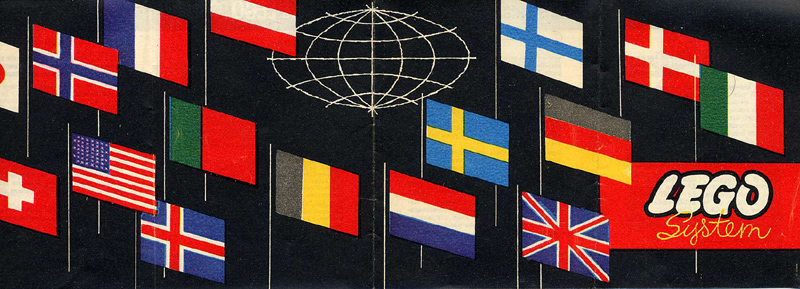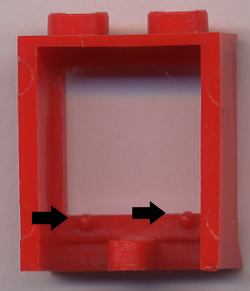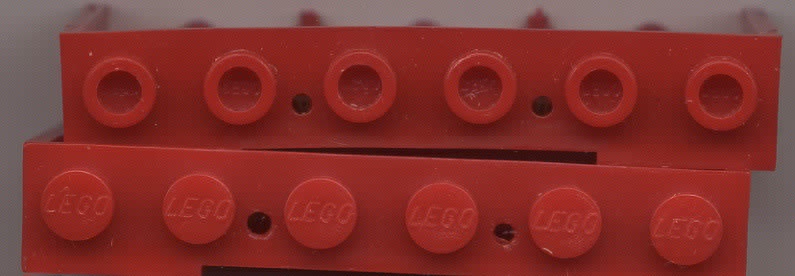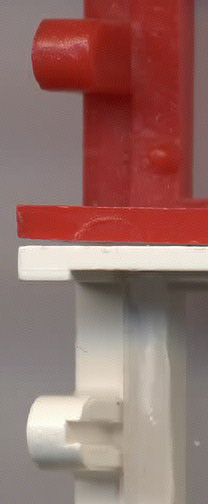
Evolution of the early LEGO® windows
Windows of three types (4, 6 and 8 panes) and one type of door were produced, all copies of Kiddicraft fixtures. All were double sided.
Initial colours seem to have been white, red and green. Subsequently came yellow, several shades of blue, etc. There are many clones, some of them exact imitations sometimes done in aberrant colours, such as pink, or with panes of varying dimensions, or one-sided (without back detail).
These seem to have been used well into 1954.
Five types/sizes of window and one door were produced. All these had continuous lateral wings to fit into slots like a guillotine. All fixtures had a rectangle of plastic glass glued on to the inside. In all windows the "glass" was clear but in the larger size (center of the image above) the "dogbone" LEGO logo was branded on the center (faintly visible in the image). On the door the glass was clouded.
The size was compatible with building models on a rough 1:60 scale and were thus a product of the ABB era. These windows were seemingly sold only in Scandinavia, until at least the end of 1955.
The third version of LEGO windows corresponds to the change from a circa 1:60 scale to a circa 1:83 scale that characterizes the System i Leg .
Six windows and one door were produced (with versions opening both left and right- see above). They are not equipped with "glass".
The windows and door have small partial side wings but these are no longer intended for the Automatic Binding Bricks of old, but rather for the 1X2vs03 bricks. Also, they are to be mounted according to a new scheme: the window or door may be sustained by inserting just one of the small wings in a slot, and supporting the other side by laying it against the side of a brick or against another fixture (right and left wings are complementary and may interlock- a clever idea).
These fixtures do not have studs on top but even so they look familiar - they are at the right scale and are the direct predecessors of the classic LEGO windows. They were sold throughout Scandinavia and in Germany at the beginning of the export venture to that country (late 1955 or early 1956) but were soon replaced by the next type.
 |
|
|
Nine windows and one door (with versions opening right and left) were produced. These have no longer side wings (see the image above) but rather full studs with the LEGO name inscribed on their top (see the bottom image on the left side).
This version of the windows and door do not have glass but, seen from the back, two small pins are noticeable on the lower part of the interior (see the image at left). These are obviously intended to hold a plastic glass. This would have two small holes that would enter the pins. The pins would then probably be heat welded, fixing the glass in place.
Looking to the windows or door from the top, one or two small holes will be noticed (except in the small 1x wide windows). These are intended for one or two small protrusions from the top of the "glass" which should also be heat-welded in place.
But either because this method proved insufficient for a satisfactory mounting, or because it was difficult to position the glass, given the diminutive size, the method could not be satisfactorily implemented in due time. So, the windows were initially introduced without glass.
NOTE: Windows without "LEGO" on the studs are clones or forgeries.
|
|
Identical with the above (same mold) but with glass glued from the interior.
When the glass was finally mounted, the likely heat-welding solution had seemingly been abandoned and although the pins were there and the glass had the corresponding holes (see image above) it was glued. So, the pins became an useless and annoying fixture, as the top holes were enough to position a glued glass.
Since the pins were useless, the molds were remachined to produce windows without pins. But there was a stock of glasses, and so for several months glasses previously made with the two holes were used on windows without the pins that were intended to receive them. The figure at left compares the lower sill of two doors- the one at the right side is vs04b and the pins are clearly visible; on the left side an early vs04c without pins but still with a holed glass pane.
When the stock of old glass panes was used up, plastic glasses without the two pinholes were still used on frames with full studs.

The full studs on vs04 windows are not merely the permanence of an archaic trait, but rather a mold necessity. Because of the shape of windows, hollow studs would result in jamming of the molded piece in the core of the mold, making ejection difficult or impossible. So, the first windows were molded in the easiest possible manner, albeit at the cost of a slower cycle or else concave stud surfaces.
Eventually the problem was solved by hollowing the studs from the exterior. Probably the mold had movable pins, one for each stud hole, that would retract at the end of each cycle, freeing the windows and sprue. This was vs05 which is similar to vs04c except for the studs that are hollow in the exterior. The "LEGO" script is now stamped at the bottom of the stud hollows and, in fact, quite invisible.
|
|
 |
Already out of our range of interest, the next window version was introduced in the 1960s. The "LEGO" script is taller; the pinholes on top of all but two of the windows disappeared (the left image above compares- top- the new version with- bottom- vs05); and the bottom connectors are now also hollow. The image above, on the right side, compares an old type window (red) with a vs06 (white).
There are other smaller details that separate both versions but the pinhole absence is the fastest identifier. On 1X window types, where no pin holes exist in any of the versions, the tall script is the most direct identifier.